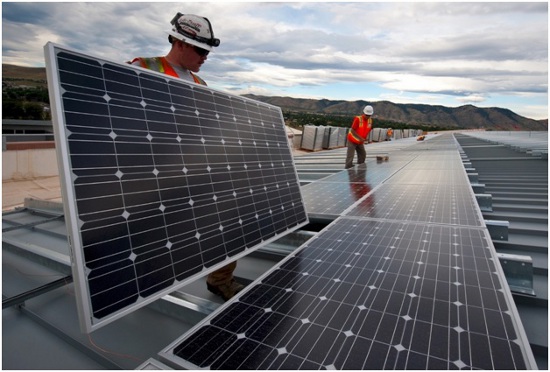Did you know that in 2021 alone, the solar industry in the U.S reached almost $33 billion?
With enough solar panels, you can power an entire home. The the question is, how do you connect solar panels to the grid?
Well, it’s not as hard as you think. Thanks to the internet, learning how to connect your solar panels is easy and hassle-free.


Want to learn how to connect solar panels to the grid? Below, we’ll go over how to connect your solar panels to the grid and answer some frequently asked questions. That way, you can feel free to power your home with the sun!
Determine Your Solar Needs
Solar panels are an important part of deciding your solar needs, as it can determine how much energy you will need and whether or not you should install solar panels. Solar panels collect solar energy, which is light and heat from the sun, and convert it into electricity.
Depending on the size of your home, the location, and your budget, it is important to research the type and number of solar panels needed to meet your electricity demands. You can find out the number of solar panels you will need by assessing your energy needs or contact a solar panel expert for a recommendation.
Additionally, you should also account for future energy needs, such as an increase in electricity requirements due to extra appliances or day-to-day activities. Solar panels can be expensive, but with the right planning, you can determine your solar needs to reduce the cost of powering your home.
Obtain Necessary Permits
Installing solar panels to the grid requires a permit from the local power company. It is also necessary to obtain installation permits from the local authorities.
First, you must assess your requirements and ensure that the system meets the necessary grid connections standards and codes. Depending on the region, the exact requirements for permits may vary. Generally, permits are required to ensure the grid remains safe and secure when solar panels are connected.
It is important to apply for the necessary permits before installation begins. The permit applications can be extensive and take some time to be shipped and approved.
The application should include information on the:
- Size of the system
- Solar array location
- Available space
- Details of the proposed installation
Once the permit application is approved, the installation contractor can begin the process of connecting the solar array to the grid.
Purchase the Required Equipment and Connections
Depending on your energy needs, you will likely need to purchase several equipment and wirings. This includes grid-tie inverters and other components, utility supplied ground fault interrupters, combiner or disconnect boxes, power conditioning units, and the necessary wiring.
You may opt to include batteries to store the energy your solar panels generate, as well as charge controllers or micro-inverters. When all the necessary equipment has been purchased, a qualified electrician can install and connect the grid-tie inverter to the grid and to the solar panels.
Plan the Wiring and Power Supply Network
It begins with choosing an appropriate wiring path from the solar array to the power inverter. A switchboard should be installed to protect the system from overloads and electrical surge.
Depending on the structure and size of the system, a microinverter or a string inverter can be used to convert the DC power produced by the solar panels into AC power.
Grounding systems may also be required to protect the system from lightning strikes. Additionally, all cables should be supported properly and an appropriate level of insulation should be maintained at all times.
Care should also be taken to arrange the solar panels in a way that maximizes their capacity and efficiency. Finally, an appropriate feed-in tariff from the utility company must be agreed upon and regulatory approvals obtained before connecting the system to the grid.
Install the Solar Panels
Installing the solar panels is a relatively simple process. After the solar panel system has been designed and purchased, the first step is to mount the solar panels on the roof of your home in an area that gets the most direct sunlight. New York State Solar Farm provides expert solar installation in New York.
The systems must be wired. First the negative (black) and positive (red) wires from the solar array must be connected to the DC side of the combiner box.
Then the array ground wires must be connected to one of the grounding lugs. The AC side of the combiner box must be wired to the inverter with AC cabling and a ground wire.
Afterwards, the system can be connected to the grid through the utility meter, a disconnect switch and an AC safety switch. Finally, install the lightning and surge protection to ensure complete system protection. This completes the solar panel installation and connection to the grid.
Install the Grid-Tie Inverter
To install a grid-tie inverter and connect solar panels to the grid, it is important to securely attach the grid-tie inverter to the side wall, making sure it is correctly inclined and at least 6 inches above the roof line. After connection, an inspection by your local electrical inspector may be needed in order to meet relevant regulations.
Following the inspection, connect the positive and negative ports of the inverter panel to the solar panel terminals and then connect the inverter to the grid. Once connected, you can now monitor and track your panel’s performance with your utility company. Lastly, connect your electric meter to the grid-tie inverter and turn your electric meter in the direction of your panels, now you have successfully connected your solar panels to the grid.
Install a Production Meter
This meter is a device that reads and measures the electricity production of a system. After the installation of the meter, the electricity will then be sent to the grid. The home power grid connection should be completed by a qualified electrician and will be inspected prior to connection.
The installation of a production meter must then be conducted by a certified authority in order to make sure that the solar installation is up to standard and is allowed to be connected to the grid. It is important to make sure that the wiring is done properly and that all safety regulations are followed.
Install a Connection Panel
This panel is composed of various systems such as an inverter, charge controller and monitoring systems. All three components must be connected and configured properly in order to access the grid.
The inverter needs to be connected to an AC power source so that incoming solar energy is converted to usable AC power. This AC power will then be connected to the grid through the connection panel.
The charge controller regulates the charge going into the battery and prevents it from overcharging or discharging. Lastly, the monitoring systems collect data on the solar photovoltaic system so that it can be managed and maintained.
Notify Your Utility Company
Once you have installed your solar panels, the next step is to connect them to the utility grid. This is a complex process and should be handled by a qualified premier solar company.
Before you proceed, it is important to make sure that your utility company is aware of your plans because they will need to approve the connection. You must notify your utility company in writing, with a copy of your installation paperwork to prove that your solar panels are up to code.
Once approved, the utility company will work with you to plan the details of your grid connection, such as the meter, the wires, and any required inspections. Lastly, once the installation is complete and the solar panels are connected to the grid, the utility company will conduct any final inspections and activate your system.
Test the System
Solar panels need to be tested before they can be connected to the system. This can be done by firstly, testing the output of each solar panel to ensure they are all correctly producing the desired output.
Secondly, all individual solar panels need to be connected in the correct order and orientation. Next, the wiring must be securely connected and checked for any possible faults or electrical shorts.
Finally, the entire system must be tested to make sure the power generated by the solar panels is being sent to the right places and none of it is being wasted. After all of this is done, the solar panel system can be connected to the power grid or other sources of energy and used to generate electricity.
These Guide Will Help You Connect Solar Panels in No Time
To conclude, connecting solar panels to the grid is easy, however there are some steps and precautions one needs to take. It is important to ensure the safety of the property and the local environment.
Consider taking advantage of opportunities available in your area to connect solar panels to the grid for an eco-friendly lifestyle. If you have any questions, contact a professional for further advice.
Did this guide help you? Browse the rest of this section for more advice on a variety of topics.
























